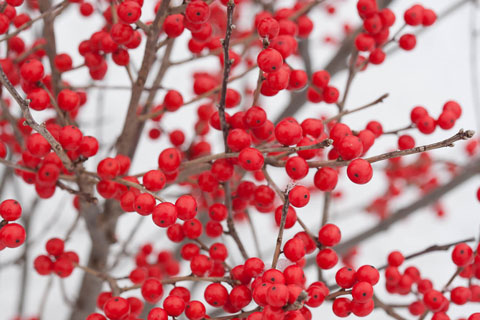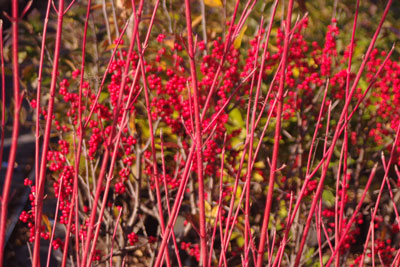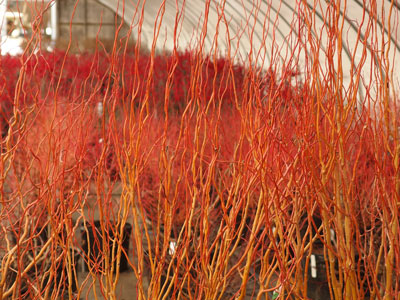1/1/2022
Winter Wonderland
Andrew Bunting
As fall transitions into winter, those trees and shrubs that can provide winter interest become components to the success of a winter garden. Just off of my back patio is one of the very first plants I added to my garden more than 20 years ago: a paperbark maple, Acer griseum. Twelve months out of the year it has stunning, peeling, coppery bark. Today, the tree is about 25-ft. tall with a spread of about 15 ft. In the fall, the foliage turns shades of orange and red, and ultimately reveals the stunning bark. Closely related with more of a tawny colored bark is the three-flowered maple, Acer triflorum.
Perennial Winter Favorites
A favorite group of plants I’ve used over the years for exceptional winter interest are the deciduous winterberry hollies. Many cultivars have come and gone, but Ilex verticillata Winter Red and Winter Gold remain two of the best. Like all hollies, there are male and female plants, and a male plant needs to be in the vicinity to aide in production of good fruit on the female plants. For both of these selections, Southern Gentleman is one of the best male pollinators.
 Winter Red reaches 10-ft. tall and about 6- to 8-ft. wide at maturity. The shiny-red fruits start ripening and turning red in late summer. When the leaves drop in the fall the naked branches are laden with an abundance of fire engine-red-colored fruits that can last from mid-September to mid-March. Occasionally, a flock of robins or catbirds will come through and devour them, but in large part the fruits remain intact all winter long, providing stunning ornamental fruit for the winter landscape. Winter Gold is a little misleading in that the fruits are more of a soft salmon-orange than golden in color. However, they’re still an amazing addition to the winter landscape.
Winter Red reaches 10-ft. tall and about 6- to 8-ft. wide at maturity. The shiny-red fruits start ripening and turning red in late summer. When the leaves drop in the fall the naked branches are laden with an abundance of fire engine-red-colored fruits that can last from mid-September to mid-March. Occasionally, a flock of robins or catbirds will come through and devour them, but in large part the fruits remain intact all winter long, providing stunning ornamental fruit for the winter landscape. Winter Gold is a little misleading in that the fruits are more of a soft salmon-orange than golden in color. However, they’re still an amazing addition to the winter landscape.
Maryland Beauty and Red Sprite are also excellent red selections. Ilex Berry Poppins is a more diminutive selection like Red Sprite, reaching only 3- to 4-ft. tall at maturity with an equal spread. Mr. Poppins is a good male pollinator for Berry Poppins. Ilex verticillata Berry Heavy reaches 6- to 8-ft. tall with an abundance of orange-red fruits. Meanwhile, for golden fruits, there’s Ilex Berry Heavy Gold, as well as Golden Verboom for soft yellow fruits.
All the winterberry hollies, Ilex verticillata, also make great cut branches for the holiday season and then can be used for decorating wreaths and swags as well.
Pictured: Berry Poppins winterberry holly. Photo: Proven Winners
More Winter Options
For the winter landscape, there are many great shrubby dogwoods with colored stems. For my local horticultural society—the Swarthmore Horticultural Society—I just did a planting recently and used Cornus sericea Cardinal. This selection of the red osier dogwood can grow up to 6- to 7-ft. tall in a growing season. I also planted several in a bed mixed with evergreens that can provide a good backdrop to set off the coral stems.
Good evergreens to mix with Cardinal would be Skimmia japonica or many of the inkberry holly selections, Ilex glabra, including Shamrock, Gem Box and Strongbox (Gem Box and Strongbox are also both being promoted as alternatives for the boxwood, which suffers from boxwood blight in many parts of the country).
 Cornus sericea Cardinal is a multiple-stem shrub. In the summer, the branches—which have the thickness of a pencil— are green, but in late fall they start to change and turn a stunning salmon-orange for the winter. The stems can be cut for winter arrangements. In late winter to early spring, the stems can be cut all the way to the ground or cut back partially to rejuvenate the shrub and create an abundance of new stems, which will be the most brightly colored the subsequent winter.
Cornus sericea Cardinal is a multiple-stem shrub. In the summer, the branches—which have the thickness of a pencil— are green, but in late fall they start to change and turn a stunning salmon-orange for the winter. The stems can be cut for winter arrangements. In late winter to early spring, the stems can be cut all the way to the ground or cut back partially to rejuvenate the shrub and create an abundance of new stems, which will be the most brightly colored the subsequent winter.
Other selections that are great for winter interest include Arctic Fire with deep red to burgundy stems. Cornus sericea Arctic Fire Yellow brings golden-yellow stems that really brighten the winter landscape. Cornus sanguinea Midwinter Fire reaches about 5- to 6-ft. tall, and over time, the clumps will grow in size. The stem color is similar to that of Cardinal, but is more a suffusion of orange and salmon. Cornus sanguinea Arctic Sun is similar in color to Midwinter Fire. All of the shrubby dogwoods are great in the landscape, but also are great.
Pictured: Cornus sericea Cardinal. Photo: Lisa Strovinsky, Pleasant Run Nursery
Don’t Forget the Willows
Also, for beautiful winter stems look to some of the willows. Salix alba Chermesina has a profusion of bright golden-orange stems all winter long. To best display this willow it should be either cut back to the ground every year or cut back to a stump of 3- to 4-ft. tall. This severe pruning will result in a very shrubby habit, and therefore, the production of many stems, which will result in the best winter interests. Like many willows, Chermesina has great vigor and can grow 6- to 7-ft. tall during the growing season.
 Swizzlestick is a corkscrew willow with dramatic twisting stems that add an architectural element to the winter landscape, but also turn a golden orange color like Chermesina.
Swizzlestick is a corkscrew willow with dramatic twisting stems that add an architectural element to the winter landscape, but also turn a golden orange color like Chermesina.
Pictured: Salix Swizzlestick. Photo: Lisa Strovinsky, Pleasant Run Nursery
Like the dogwoods, the willows with colored stems are great for:
• Cutting branches for winter interest
• Adding to the landscape in mass plantings
• Adding to a container for winter interest
Combining all of the aforementioned, the maples, winterberry hollies, shrubby dogwoods and willows will add considerable winter interest to the garden and landscape. GP
Andrew Bunting is the Vice President of Public Horticulture for the Pennsylvania Horticultural Society, which uses horticulture to advance the health and well-being of the Greater Philadelphia region. Andrew has decades of horticultural experience, ranging from his tenures at public gardens in the U. S. and abroad, as well as a published author, gardening expert and sought-after presenter. To learn more about PHS or to become a member and support greening initiatives in over 250 neighborhoods, visit PHSonline.org.